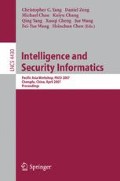Abstract
Anticipatory Event Detection (AED) is a framework for monitoring and tracking important and relevant news events at a fine grain resolution. AED has been previously tested successfully on news topics like NBA basketball match scores and mergers and acquisitions, but were limited to a static event representation model. In this paper, we discuss two recent attempts of adding content burstiness to AED. A burst is intuitively a sudden surge in frequency of some quantifiable measure, in our case, the document frequency. We examine two schemes for utilizing the burstiness of individual words, one for revamping the static document representation, and the other for extracting bursty and discriminatory words from the two states of the AED Event Transition Graph.
Access this chapter
Tax calculation will be finalised at checkout
Purchases are for personal use only
Preview
Unable to display preview. Download preview PDF.
References
Wikipedia: Open source intelligence, http://en.wikipedia.org/wiki/open_source_intelligence
He, Q., Chang, K., Lim, E.-P.: A model for anticipatory event detection. In: Embley, D.W., Olivé, A., Ram, S. (eds.) ER 2006. LNCS, vol. 4215, pp. 168–181. Springer, Heidelberg (2006)
Allan, J.: Topic Detection and Tracking. Event-based Information Organization. Kluwer Academic Publishers, Dordrecht (2002)
He, Q., Chang, K., Lim, E.P.: Anticipatory event detection via sentence classification. In: IEEE SMC Conf., pp. 1143–1148 (2006)
Kleinberg, J.: Bursty and hierarchical structure in streams. In: SIGKDD, pp. 91–101 (2002)
TDT03: Topic detection and tracking dataset 3 (2003), http://projects.ldc.upenn.edu/tdt3
Salton, G., Buckley, C.: Term-weighting approaches in automatic text retrieval. Information Processing and Management 24, 513–523 (1988)
He, Q., Chang, K., Lim, E.-P.: Bursty feature representation for clustering text streams. In: SIAM Datamining Conference (to appear, 2007)
Author information
Authors and Affiliations
Editor information
Rights and permissions
Copyright information
© 2007 Springer Berlin Heidelberg
About this paper
Cite this paper
Chang, K., He, Q., Aminuddin, R., Suri, R., Lim, EP. (2007). Anticipatory Event Detection for Bursty Events. In: Yang, C.C., et al. Intelligence and Security Informatics. PAISI 2007. Lecture Notes in Computer Science, vol 4430. Springer, Berlin, Heidelberg. https://doi.org/10.1007/978-3-540-71549-8_19
Download citation
DOI: https://doi.org/10.1007/978-3-540-71549-8_19
Publisher Name: Springer, Berlin, Heidelberg
Print ISBN: 978-3-540-71548-1
Online ISBN: 978-3-540-71549-8
eBook Packages: Computer ScienceComputer Science (R0)

